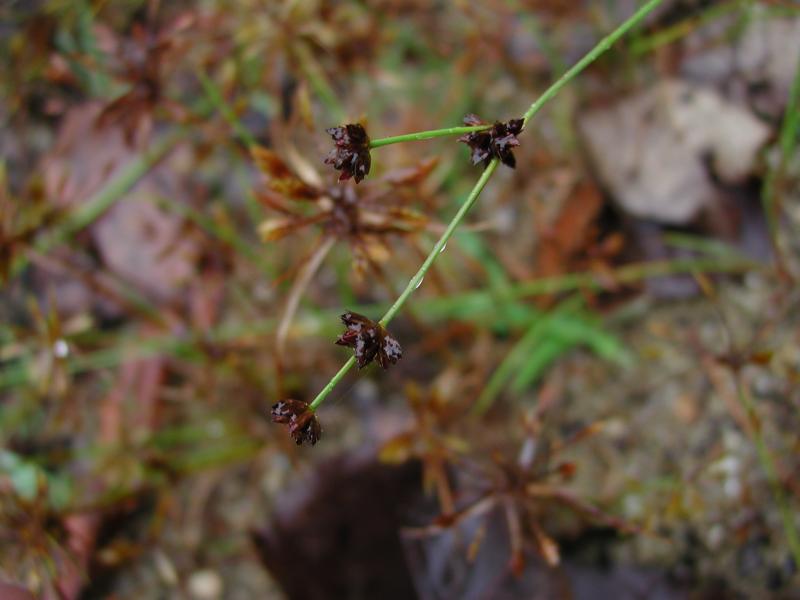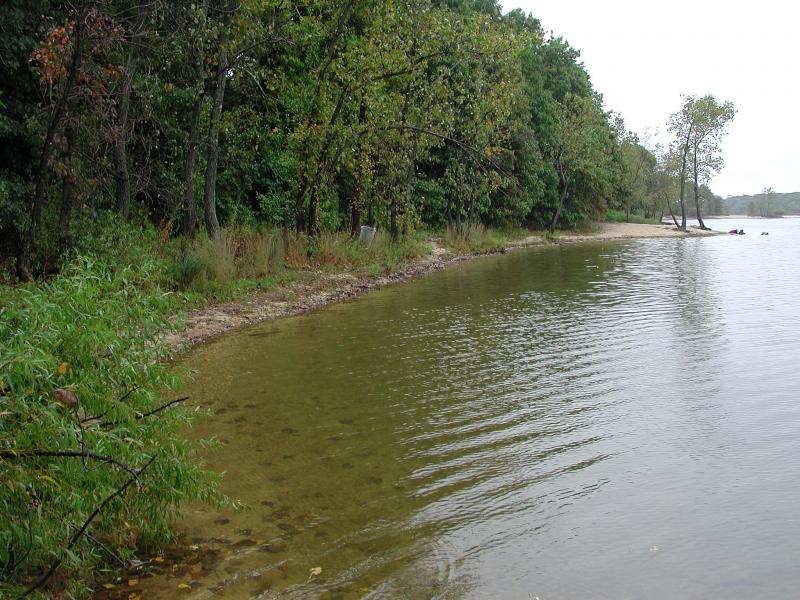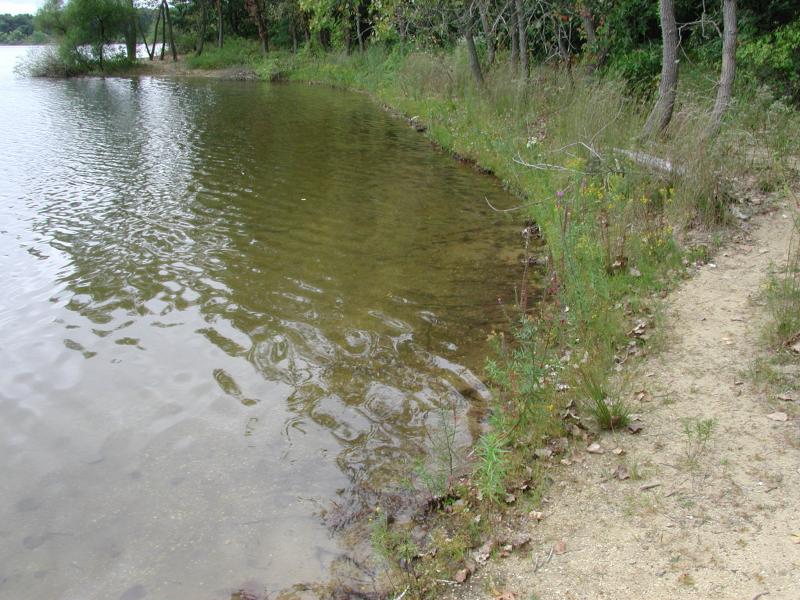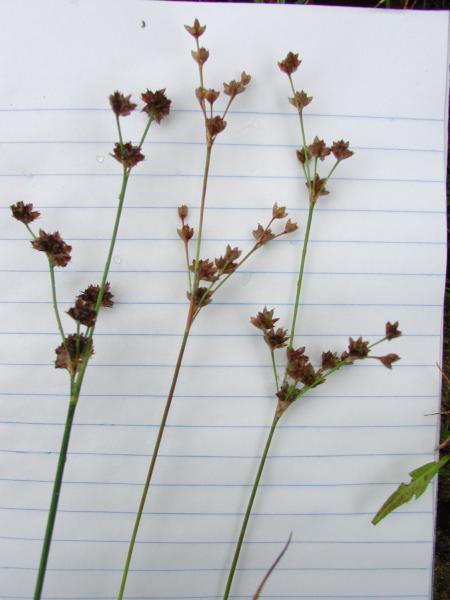Weak Rush
Juncus debilis Gray
- Class
- Monocotyledoneae (Monocots)
- Family
- Juncaceae (Rush Family)
- State Protection
- Endangered
Listed as Endangered by New York State: in imminent danger of extirpation in New York. For animals, taking, importation, transportation, or possession is prohibited, except under license or permit. For plants, removal or damage without the consent of the landowner is prohibited.
- Federal Protection
- Not Listed
- State Conservation Status Rank
- S1
Critically Imperiled in New York - Especially vulnerable to disappearing from New York due to extreme rarity or other factors; typically 5 or fewer populations or locations in New York, very few individuals, very restricted range, very few remaining acres (or miles of stream), and/or very steep declines.
- Global Conservation Status Rank
- G5
Secure globally - Common in the world; widespread and abundant (but may be rare in some parts of its range).
Summary
Did you know?
This is one of the smallest species of Juncus in the state, reflected in the species name meaning "weak." Many populations may be undiscovered because of its resemblance to Juncus brachycarpus, Juncus acuminatus and Juncus subcaudatus.
State Ranking Justification
There are four existing populations but only one of them is of good quality. The other three have less than 60 plants each and are under some threat by human disturbance. There are five historical occurrences but most of them are too vague for targeted searches.
Short-term Trends
Short-term trends are not well known since only one population has been revisited in recent years and the plants were extirpated by changes in habitat. This plant occurs in habitats that could undergo change in a short time.
Long-term Trends
This plant has only ever had five or fewer occurrences in New York at any one time. Some historical occurrences are too vague to know whether they still exist and others are from locations where the habitat probably no longer exists. As some locations are lost and others are discovered the plant will probably continue to exist in small numbers in the state.
Conservation and Management
Threats
One population is around a lake where it can be trampled by people fishing and walking.
Conservation Strategies and Management Practices
Make sure the plants are protected from human impacts.
Research Needs
Research is needed to discover what limits the distribution of this plant in New York since there are many wet shorelines where it could live.
Habitat
Habitat
Juncus debilis has been collected from a rather broad variety of habitats in New York, including red maple swamps, mudflats, shallow emergent marshes, and coastal plain pond shores. More information on the habitat requirements of this small and possibly overlooked species in the state is needed (New York Natural Heritage Program 2007). Wet places, shores, etc. (Fernald 1970). Moist sandy soil (Gleason & Cronquist 1991).
Associated Ecological Communities
- Brackish intertidal mudflats*
(guide)
A sparsely vegetated community, characterized by low-growing, rosette-leaved aquatics. The community occurs on exposed intertidal mudflats where water salinity ranges from 0.5 to 18.0 ppt. This community is best developed where mudflats are nearly level so that broad expanses are exposed at low tide. The rosette-leaved aquatics are completely submerged at high tide, and they are usually coated with mud.
- Coastal plain pond shore*
(guide)
The gently sloping shore of a coastal plain pond with seasonally and annually fluctuating water levels. Plants growing on the pond shore vary with water levels. In dry years when water levels are low there is often a dense growth of annual sedges, grasses, and herbs. Submerged and floating-leaved aquatic plants, such as fragrant waterlily and pondweeds, may become "stranded" on the exposed shore. In wet years when the water level is high only a few emergents and floating-leaved aquatics may be noticeable. T
- Red maple-hardwood swamp*
(guide)
A hardwood swamp that occurs in poorly drained depressions, usually on inorganic soils. Red maple is usually the most abundant canopy tree, but it can also be codominant with white, green, or black ash; white or slippery elm; yellow birch; and swamp white oak.
- Shallow emergent marsh
(guide)
A marsh meadow community that occurs on soils that are permanently saturated and seasonally flooded. This marsh is better drained than a deep emergent marsh; water depths may range from 6 in to 3.3 ft (15 cm to 1 m) during flood stages, but the water level usually drops by mid to late summer and the soil is exposed during an average year.
* probable association but not confirmed.
Associated Species
- Agrostis gigantea (red-top)
- Bulbostylis capillaris (tufted hair sedge)
- Cardamine pensylvanica (Pennsylvania bitter cress)
- Carex lurida (sallow sedge)
- Carex scoparia (pointed broom sedge)
- Carex vulpinoidea (fox sedge)
- Carpinus caroliniana
- Conyza canadensis
- Cyperus filicinus (fern flat sedge)
- Eleocharis palustris (common spike-rush)
- Eupatorium serotinum (late thoroughwort)
- Euthamia caroliniana (slender flat-topped-goldenrod)
- Galium aparine (cleavers)
- Glyceria canadensis (rattlesnake manna grass)
- Gratiola aurea (golden hedge-hyssop)
- Hydrocotyle americana (American marsh-pennywort)
- Juncus acuminatus (sharp-fruited rush)
- Juncus canadensis (Canada rush)
- Juncus dichotomus (forked rush)
- Juncus effusus
- Juncus marginatus (common grass-leaved rush)
- Juncus pelocarpus (brown-fruited rush)
- Mimulus ringens (Allegheny monkey-flower)
- Onoclea sensibilis (sensitive fern)
- Panicum virgatum (switch grass)
- Persicaria hydropiperoides (mild water-pepper)
- Persicaria punctata (dotted smartweed)
- Polygonum sagittatum
- Scirpus atrovirens (dark-green bulrush)
- Spiraea tomentosa (steeplebush)
- Thelypteris palustris
Range
New York State Distribution
In New York Juncus debilis is known only from Long Island, the Hudson Highlands west of the Hudson River, and along the Delaware River.
Global Distribution
Juncus debilis reaches to northern tip of its range in far southern New York, New Jersey, and eastern Pennsylvania. From there its distribution arcs southwest, including the coastal states to northern Florida and eastern Texas, as well as Kentucky, Tennessee, Illinois, Missouri, and Arkansas in the interior.
Identification Comments
General Description
Weak Rush is a tufted, grass-like perennial. Its stems are erect, round, smooth, and only 10 to 25 cm tall and 1-2mm wide. There are 1-3 dark green to purplish leaves along the stem, from 1 to 12.5 cm long and .5 to 1.5 mm wide. The flowers are borne in 3 to 35 heads on widely-spreading branches, each head with from 2-10 (20) flowers. As with all rushes, each flower has 6 tepals (reduced petal-like structures); in J. debilis these are green to straw-colored, up to 2.3 mm long, and have pointed tips. The fruit are capsules 2.8 to 3.7 mm long, exceeding the length of the perianth (tepals).
Best Life Stage for Proper Identification
This species is best identifed when mature fruit are present.
Similar Species
Juncus acuminatus and J. brachycarpus each have tepals which are much longer than the fruit. J. subcaudatus has seeds .7 to 2.6 mm long, each with a tail and a white translucent veil, while those of J. debilis are only .3 to .4 mm long and lack tails or veils (FNA 2000).
Best Time to See
The fruits on this species ripen in late July or early August and can persist into the fall.
- Fruiting
The time of year you would expect to find Weak Rush fruiting in New York.
Weak Rush Images
Images of Similar Species
Taxonomy
Weak Rush
Juncus debilis Gray
- Kingdom Plantae
- Phylum Anthophyta
- Class Monocotyledoneae
(Monocots)
- Order Juncales
- Family Juncaceae (Rush Family)
- Order Juncales
- Class Monocotyledoneae
(Monocots)
- Phylum Anthophyta
Synonyms
- Juncus acuminatus var. debilis (A. Gray) Engelm.
- Juncus diffusissimus Buckl. [Misapplied to New York specimens.]
Additional Resources
Best Identification Reference
Flora of North America Editorial Committee. 2000. Flora of North America north of Mexico. Vol. 22. Magnoliophyta: Alismatidae, Arecidae, Commelinidae (in part), and Zingiberidae. Oxford Univ. Press, New York. xxiii + 352 pp.
Other References
Clemants, Steven E. 1990. Juncaceae (rush family) of New York State. Contributions to a flora of New York State VII Richard S. Mitchell, ed. New York State Museum Bulletin No. 475. 67 pp.
Crow, Garrett E. and C. Barre Hellquist. 2000. Aquatic and Wetland Plants of Northeastern North America: A revised and enlarged edition of Norman C. Fassett's a Manual of Aquatic Plants. Volume One: Pteridophytes, Gymnosperms, and Angiosperms: Dicotyledons. The University of Wisconsin Press. Madison, Wisconsin. 536 Pages.
Fernald, M.L. 1950. Gray's manual of botany. 8th edition. D. Van Nostrand, New York. 1632 pp.
Gleason, Henry A. and A. Cronquist. 1991. Manual of Vascular Plants of Northeastern United States and Adjacent Canada. The New York Botanical Garden, Bronx, New York. 910 pp.
Holmgren, Noel. 1998. The Illustrated Companion to Gleason and Cronquist's Manual. Illustrations of the Vascular Plants of Northeastern United States and Adjacent Canada. The New York Botanical Garden, Bronx, New York.
New York Natural Heritage Program. 2010. Biotics database. New York Natural Heritage Program. New York State Department of Environmental Conservation. Albany, NY.
New York Natural Heritage Program. 2024. New York Natural Heritage Program Databases. Albany, NY.
Rhoads, Ann F. and Timothy A. Block. 2000. The Plants of Pennsylvania, an Illustrated Manual. University of Pennsylvania Press, Philadelphia, PA.
Weldy, T. and D. Werier. 2010. New York flora atlas. [S.M. Landry, K.N. Campbell, and L.D. Mabe (original application development), Florida Center for Community Design and Research http://www.fccdr.usf.edu/. University of South Florida http://www.usf.edu/]. New York Flora Association http://newyork.plantatlas.usf.edu/, Albany, New York
Weldy, Troy W. and David Werier. 2005. New York Flora Atlas. [S.M. Landry, K.N. Campbell, and L.D. Mabe (original application development), Florida Center for Community Design and Research. University of South Florida]. New York Flora Association, Albany, NY. Available on the web at (http://newyork.plantatlas.usf.edu/).
Links
About This Guide
Information for this guide was last updated on: January 18, 2008
Please cite this page as:
New York Natural Heritage Program. 2024.
Online Conservation Guide for
Juncus debilis.
Available from: https://guides.nynhp.org/weak-rush/.
Accessed July 27, 2024.



